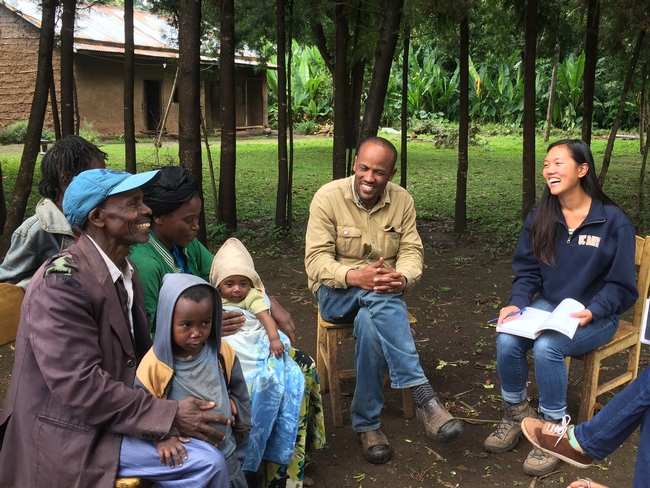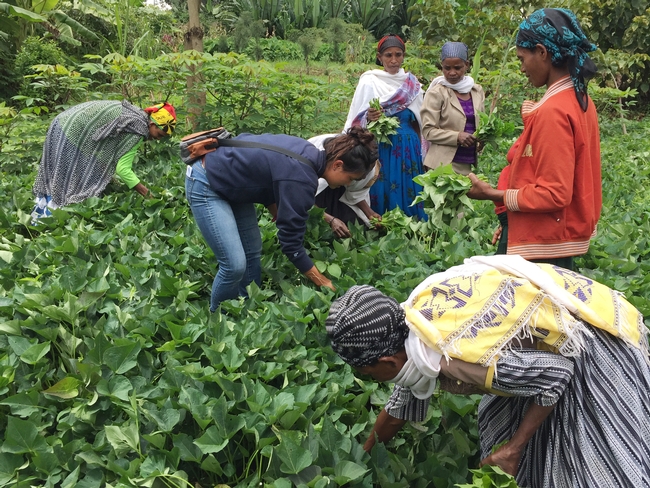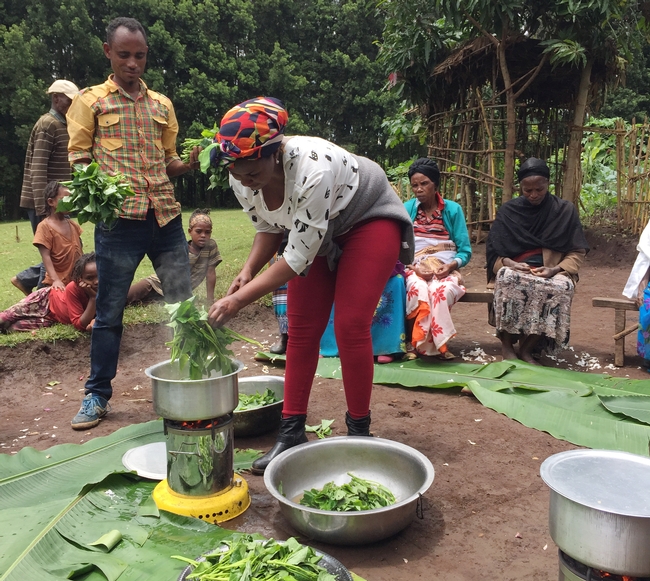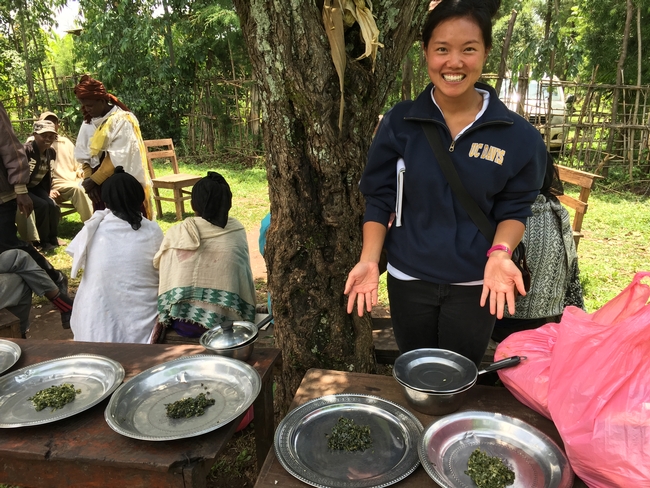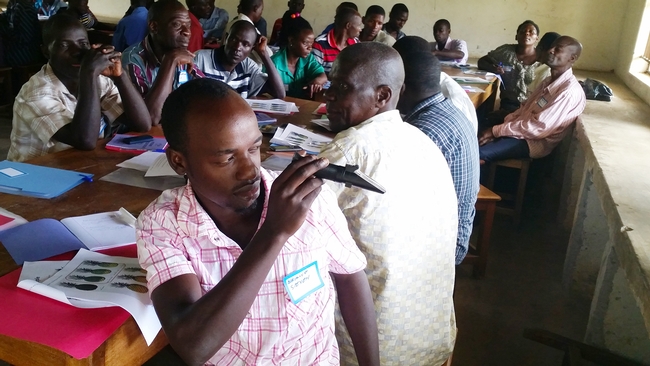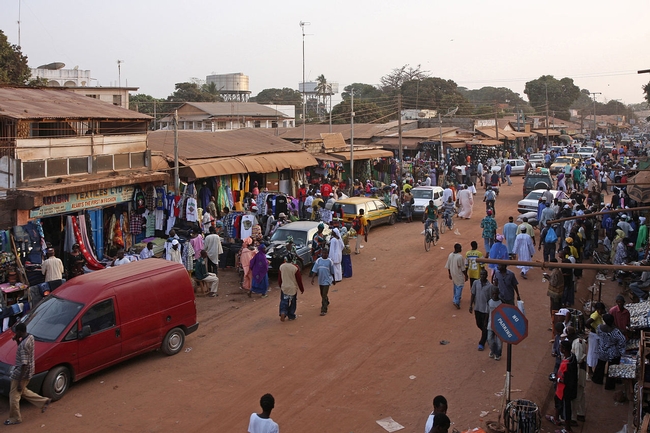
Posts Tagged: Africa
Trying leafy greens from a sweet potato plant
This time of year, it can be hard to resist the pull of sweet potatoes — roasted, mashed with butter, and topped with a combination of delectable treats from maple syrup to pecans to marshmallows. But did you know that the green leaves of the sweet potato plant also have the potential to be a tasty, nutritious food?
In Ethiopia, where sweet potatoes can be a staple crop, UC Davis graduate student Lauren Howe recently helped farmers taste test the leaves and consider this familiar crop in a new culinary light.
Watch a video to learn how to prepare sweet potato leaves:
The leaves of this drought-tolerant plant offer farming households there an alternative — and nutritious — food in the lean season, while they are waiting for its starchy, tuberous roots to be ready to eat. Introducing sweet potato leaves as a food option is intended to help farmers better diversify their families' diets, to include a wider variety of vegetables in addition to staple foods, especially during the dry season.
Lauren shared her experiences in Ethiopia on the Agrilinks website, where she recently won the Agrilinks Young Scholars blog contest with her writing and a short video from the field.
Boots on the ground with sweet potato farmers in Ethiopia
Lauren traveled to Ethiopia this summer to work with an organization called Send A Cow Ethiopia (SACE), on a Trellis Fund project. As part of the Horticulture Innovation Lab, each Trellis Fund project connects an organization in a developing country with a grad student from a U.S. university, to work together to benefit local farmers, while building the capacity of both the local organization and the student.
In Ethiopia, SACE helped Lauren better understand local contexts by connecting her with farming households to interview about their current farming practices and the role of sweet potatoes in their diets.
Later they traveled to meet with a group of about 25 farmers in the Ukara community to harvest leaves, cook together and discuss their perceptions of the leaves as a vegetable option.
Reflecting on taste tests, new foods, and rural communities
Lauren's own passion for food and witnessing how food can help build community is an important part of her reflection on this experience:
"This project is about creating tasty dishes to persuade people about the nutritional benefits of a new ingredient. It is gathering families, friends and neighbors to sit down to a communal meal (already a strong Ethiopian practice), breaking bread together, sharing stories, experiences and hopes for the future."
For more, go read the rest of Lauren's blog post and check out her short video too.
Background and related international agricultural research
Lauren's experience with a Trellis Fund project in Ethiopia was supported by the Horticulture Innovation Lab, a research program led by Elizabeth Mitcham of the UC Davis Department of Plant Sciences, with funding from the U.S. Agency for International Development. With a focus on fruit and vegetable innovation, the Horticulture Innovation Lab seeks to empower smallholder farmers in developing countries to earn more income and better nourish their communities — as part of the U.S. government's global Feed the Future initiative.
Past research from the Horticulture Innovation Lab has focused on other leafy greens, specifically African indigenous vegetables, and also on sweet potatoes themselves (orange-fleshed sweet potatoes, that is). Though the program has not done in-depth research on sweet potato leaves for human consumption beyond this small Trellis Fund project, you can find more information about eating sweet potato leaves and tips in this bulletin from the University of Arkansas Cooperative Extension, and a wealth of information about sweet potato farming and gardening from the University of California Vegetable Research and Information Center.
Related Food Blog posts:
- New reason to give thanks for sweet potatoes
How orange-fleshed sweet potatoes are making a difference in some African countries - More African indigenous vegetables on more plates
A brief look at some leafy greens popular in Eastern Africa - Connecting with farmers over pineapple postharvest practices
Another Trellis student experience with a video - ‘Local' farm inspiration from half a world away
A UC Cooperative Extension specialist reflects on his time as a Trellis student
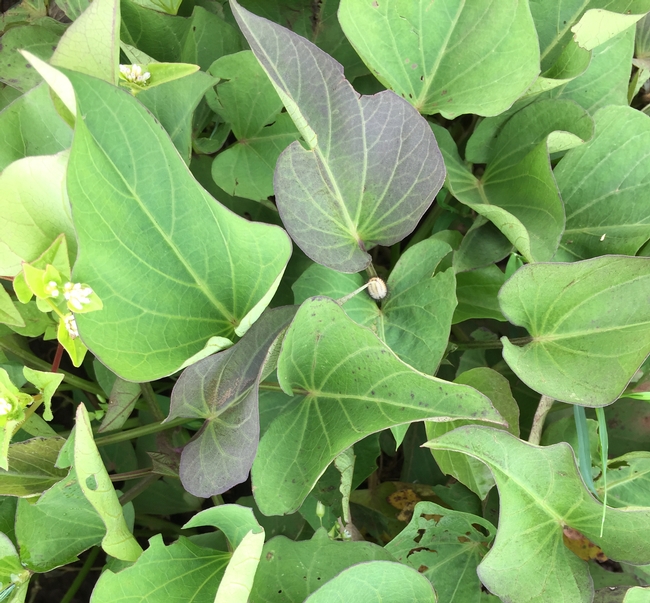
Sweet potato leaves in Ethiopia - Horticulture Innovation Lab photo by Lauren Howe/UC Davis
Word of the Day: Nototribic
The black-tailed bumble bee wasn't flying very well. You wouldn't, either, if you were trying to...
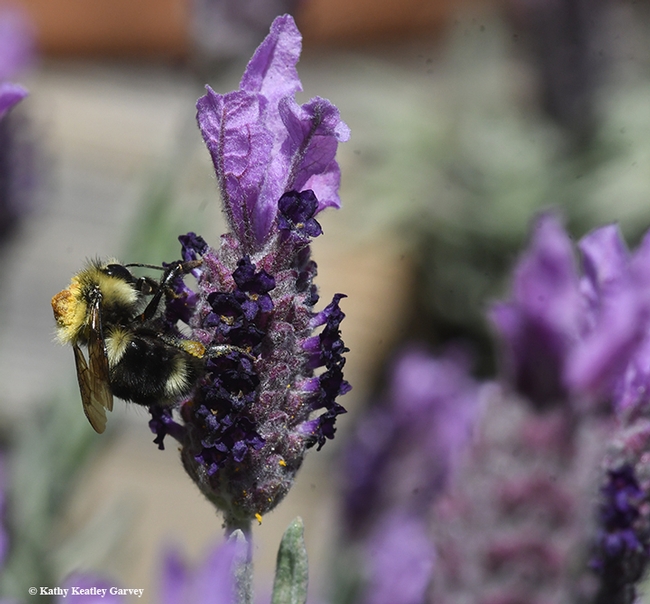
A black-tailed bumble bee, Bombus melanopygus with a thick load of resin on her thorax. She had just visited a nototribic flower. (Photo by Kathy Keatley Garvey)
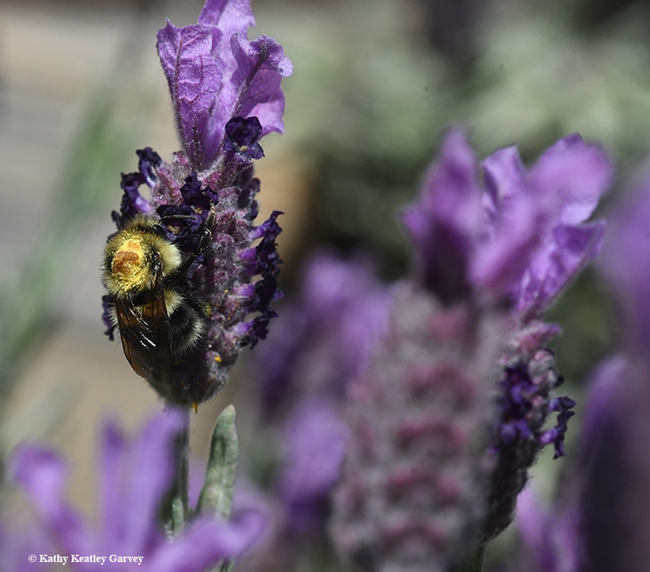
Dorsal view of the pollen hump on the back of the black-tailed bumble bee. (Photo by Kathy Keatle Garvey)
Connecting with farmers over pineapple postharvest practices
At the end of a long year, sometimes it helps to reconnect with what motivates your work.
For Karin Albornoz — a Ph.D. student who works in the Diane Beckles Lab at UC Davis on molecular biology related to tomato postharvest chilling injury — that means getting out into the world to work directly with small-scale farmers.
"I spend so much time in the lab," she said. "Sometimes I spend a whole day in the lab extracting RNA or writing a paper. This reminds me why I am doing this work: to make a real-world impact."
Just over a week ago, she returned from a trip to Uganda where she did exactly that. In partnership with a local organization called Ndibwami Integrated Rescue Project (NIRP), Albornoz shared her expertise with farmers through several hands-on workshops about improving harvest practices and postharvest handling of pineapple, passion fruit and tomatoes. Her work was supported by the Horticulture Innovation Lab, an international agricultural research program led by UC Davis with funding from the U.S. Agency for International Development as part of Feed the Future, the U.S. government's global hunger and food security initiative.
Though Albornoz has worked with rural farmers before, this was her first time working in Africa.
"Everywhere I looked, things were growing. There were people working in the field, women cooking, and everyone was working with food," she said. "I know there's a lot of stigma – when you talk about Africa, you see people's faces change and they're thinking about things like drought and famine and starving children. But what I saw doesn't fit that stereotype. The challenges they are facing seem to be about not having access to opportunities."
The workshops she led are part of the NIRP organization's efforts to connect farmers with more lucrative markets that pay higher prices for quality produce.
In this 2-minute video, Karin Albornoz visits a pineapple farm, leads a pineapple training and discusses next steps for this project led by NIRP in Uganda. The video clips and photos were taken by Karin while she was working and edited by Hallie Casey for the Horticulture Innovation Lab.
For months, Albornoz has been in contact with NIRP and making plans for the farmer workshops. She prepared postharvest handling manuals for each crop — pineapple, passion fruit and tomato — and asked questions to better understand local resources and the farmers' existing knowledge.
During her 2 weeks in Uganda, she visited farmers' fields and led three full-day workshops. The first workshop for about 50 farmers focused on pineapple — starting with understanding local quality parameters for this fruit, then best practices for harvesting, sanitation, storage and transportation. The second workshop was focused on tomato, with a similar structure, and the third workshop on passion fruit.
Her favorite moment? The farmers' first chance to use a refractometer, to measure soluble solids and learn about sugar levels in the fruit. The refractometers were part of a small toolkit the organization will continue to use.
"They were excited to handle this device and see, in numbers, how the sugar levels of the fruit changed depending on the stage of maturity," she said. "Everyone in the room had a chance to try it."
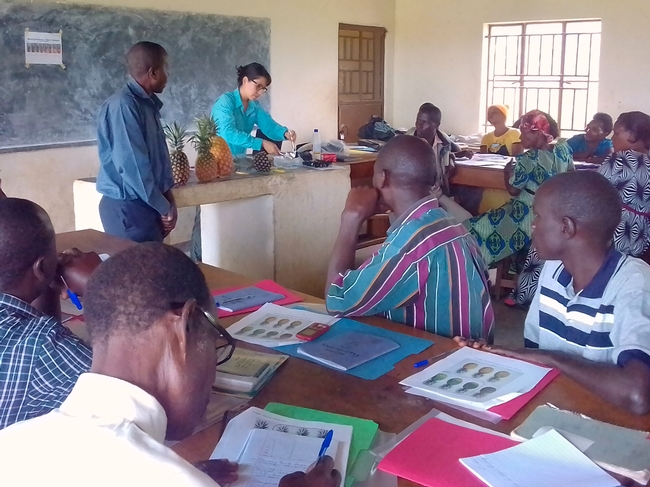
The experience reinforced her commitment to working with farmers and solving agricultural problems.
"A major mistake is to think that you are going just to train or teach other people because those people are always going to end up teaching you too," Albornoz said. "I made a promise to myself years ago, a personal commitment to working with people in vulnerable situations. I have to do this. Working in agriculture can be a very powerful tool to have an impact in the world."
As Karin's mentor and an Associate Professor in the UC Davis Department of Plant Sciences and Agricultural Experiment Station, Diane Beckles supported Karin's work outside of the lab and views such an experience as important to scholarly development.
"Something magical happens when we teach and engage in outreach," Beckles said. "We often deepen our understanding of what we are teaching, and interacting and engaging with others changes us in that process. It alters how we view and think about science in a way that is positive and rewarding, even though it is not easily quantified."
More information:
- More about Trellis Fund projects with the Horticulture Innovation Lab
- Pineapple recommendations from the UC Postharvest Center
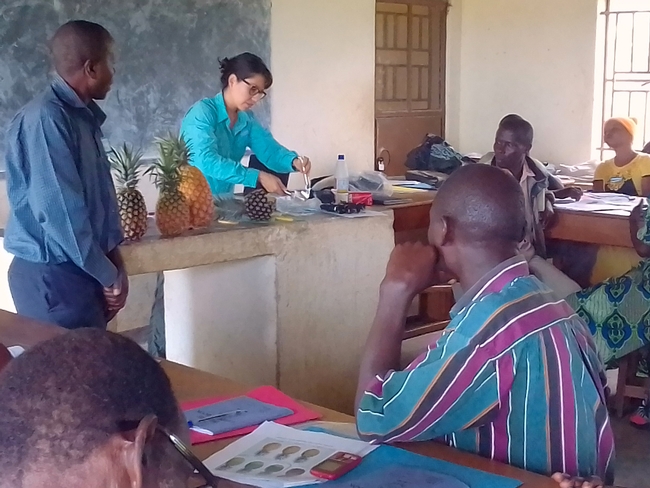
thumbnail: Karin Albornoz leads a workshop in postharvest handling of pineapple in Uganda.
Changes in breast milk sugars impact babies’ health and growth
When it comes to nursing moms and their babies, an elegant web of cause and effect connects climate, breast milk, gut microbes and infant health.
That web was clearly illustrated by a recently published study involving 33 women and their babies in the West African nation of The Gambia. The research team, including scientists from UC Davis and UC Agriculture and Natural Resources, found that complex breast milk sugars called oligosaccharides helped protect nursing babies from illness and also influenced the mixture of microbes in the infants' guts.
The researchers also showed that changes in food availability from season to season could affect the composition of the women's breast milk and the protective quality of the babies' gut microbiota. And those changes, in turn, impacted the health and growth of the breastfed infants.
Composition of breast-milk sugars and infant health
Oligosaccharides occur abundantly as more than 200 different chemical structures in human breast milk. It's been known for some time that these complex sugars contribute to infant health by supporting the growth of beneficial bacteria in the baby's gut. And these gut bacteria have been shown to play a key role in fending off infectious illnesses.
But little has been known about how changes in the composition of the breast milk sugars might affect the health and growth of infants, especially those living in areas where infection rates are high.
To explore that relationship, the researchers monitored the composition of the oligosaccharides in the mothers' milk and examined the infants' gut microbiota at 4 weeks, 16 weeks and 20 weeks after the babies were born. Then they analyzed the data, looking for possible relationships to the health and growth of the babies and the status of their gut microbes.
They found that two of the oligosaccharides, lacto-N-fucopentaose and 3′-sialyllactose, had a direct relationship to the babies' health and growth. High levels of the former were associated with a decrease in infant illness and with improved growth, measured as height for age, while the latter proved to be a good indicator of infant growth, measured by weight per age.
“Our findings provide evidence that specific human milk oligosaccharides can alter the composition of breast milk, making it more protective against infection and allowing the infant to invest energy in growth rather than fending off disease,” said the study's corresponding author Angela Zivkovic, an assistant professor of nutrition at UC Davis.
Influence of wet and dry seasons
The researchers also were curious how seasonal shifts in food availability, which significantly impact the mothers' diets, might be reflected in breast milk composition and infant health.
The Gambia has two distinct seasons, the wet season from July to October and the dry season from November to June.
The wet season is also known as the “hungry” season because it is the time of year when food supplies tend to be depleted, infection rates rise and the farming workload is highest. In contrast, the dry, or “harvest,” season is characterized by plentiful food supplies as well as significantly higher energy stores and less illness among the local people.
The researchers found that mothers who were nursing during the wet or “hungry” season produced significantly less oligosaccharide in their milk than did those nursing during the dry season.
In examining the makeup of the babies' gut microbiota, the researchers noted that most of the bacteria belonged to the Bifidobacteria genus. They also discovered that higher levels of Dialister and Prevotella bacteria were accompanied by lower levels of infection.
In addition, higher levels of Bacteroides bacteria were present in the infants' guts that had abnormal “calprotectin” – a biomarker associated with intestinal infections.
“We are very interested in which specific dietary factors influence the oligosaccharide composition of mother's milk,” Zivkovic said. “If we can find the mechanisms that change the composition of breast milk sugars, we may have a new approach for modifying the infant microbiota and ultimately influencing the health and vigor of the nursing baby.”
The study by Zivkovic and colleagues appears online in the journal Scientific Reports. The research is part of a long-running, cross-disciplinary project at UC Davis examining milk and its role in nutrition.
Funding for the study was provided by the National Institutes of Health, UK Medical Research Council, Bill and Melinda Gates Foundation, Alfred P. Sloan Foundation, and Peter J. Shields Endowed Chair in Dairy Food Science at UC Davis.
When weeds make good eats

The idea that weeds can be edible pops up periodically, with articles suggesting one person's weeds are another person's salad bar, highlighting chefs who “have a way with weeds,” discussing ways medieval gardeners encouraged weeds, and even suggesting ways to eat away at invasive species. But is this something we should take seriously?
“We call these plants weeds because of the way we interact with them. They're in our gardens, they're in our lawns, and they're competing with plants that we prefer to eat,” said Lynn Sosnoskie, a weed scientist at UC Davis. “But a lot of the plants that are weeds here in the United States were brought here purposefully—to be eaten.”
Sosnoskie's doctoral thesis was on just such a plant, with the tasty name of “garlic mustard.” She has also worked at length on Palmer amaranth, a pernicious weed found in cotton fields that can be glyphosate-resistant. In response to one Georgia farmer asking in exasperation if he should just eat the plant taking over his fields, she did some preliminary research into eating Palmer amaranth.
“It's probably not feasible to eat our way out of a serious weed problem,” she said. “But I certainly feel like we can investigate them as other potential food sources.”
In fact, the Horticulture Innovation Lab at UC Davis has a project that is researching three “indigenous vegetables” in Africa, two of which — amaranth and black nightshade — are considered weeds in the United States. The vegetables can be nutritious and profitable options for small-scale farmers in Kenya, Tanzania, Zambia and elsewhere.

Though he holds a Ph.D. in weed science, Weller is now figuring out the best ways to cultivate amaranth and black nightshade — instead of to eliminate them. Before he started working with these plants, common assumptions held that they should be easy to grow because, well, they “grow like weeds.”
“But we found out that growing them is more intensive than we were initially led to believe — similar to growing any other vegetable,” Weller said. “They need water, they need fertilizer, and pests are a problem.”
Caveat emptor: Though weedy plants can indeed be a source of food, both scientists cautioned against thinking of weeds as a “free-for-all forage buffet.” Some plants may be toxic, and weeds in farm fields may have been sprayed recently. It is important to be knowledgeable of the plants and how they've been grown before trying to eat one.

